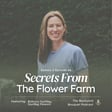
Ep. 8: Mastering the Art of Cut Flower Gardening with Master Gardener Stacy Ling
In this episode of the Backyard Bouquet Podcast, we have the pleasure of hearing from Stacy Ling, a master gardener and published author. Stacy is also a home and garden blogger who shares her passion for gardening and helps beginners find their inner green thumb.
Stacy’s gardening journey began over 25 years ago when she was inspired by her neighbor's beautiful cottage garden. Despite having no prior gardening experience, Stacy started small with houseplants and gradually expanded her gardening skills. She eventually moved to a home with more space and began planting perennials, annuals, and shrubs, creating beautiful gardens that brought her joy.
In this episode, learn the importance of starting with easy-to-grow flowers to build confidence and success in the garden. Stacy also shares her experience with winter sowing, a method of starting seeds outdoors in containers, which can be a simple and effective way to grow flowers.
Join us as we delve into the concept of companion planting and how certain flowers can attract beneficial insects and deter pests. Stacy emphasizes the importance of choosing flowers that thrive in your specific growing conditions and offers tips for selecting the right plants for your garden.
Stacy's newly released book, "The Bricks ‘N Blooms Guide to a Beautiful and Easy-Care Flower Garden" offers practical advice, design tips, and growing techniques for both beginners and experienced gardeners. Stacy's goal is to inspire and empower readers to create their own beautiful flower gardens and find joy in the process.
Whether you're a seasoned gardener or just starting out, Stacy's insights and passion for flowers will inspire you to let your backyard bloom.
Show Notes: https://thefloweringfarmhouse.com/2024/02/06/episode-8-master-gardener-stacy-ling/
In this episode:
- 00:02:00 - Stacy's background
- 00:05:30 - Learning from failures and the importance of perseverance
- 00:09:56 - Starting a cut flower garden and recommended flowers for beginners
- 00:13:42 - Winter sowing
- 00:19:46 - The importance of companion planting
- 00:23:06 - Flowers and plants that bring joy
- 00:26:07 - Involving children in gardening
- 00:30:26 - Favorite flowers for arranging bouquets
- 00:34:26 - Using fillers and greenery in flower arrangements
- 00:36:54 - Spreading joy through flowers and sharing with others
- 00:38:36 - The release of Stacy's book
- 00:53:39 - Stacy's advice for starting a garden
Learn more:
- https://stacyling.com/
- https://www.instagram.com/bricksnblooms/
- Buy Stacy’s Book: The Bricks ‘ N Blooms Guide To A Beautiful & Easy-Care Flower Garden
***Rate, Review, & Follow The Backyard Bouquet***
If you enjoyed this episode, will you please consider leaving the podcast a review?
Don’t miss new episodes every Tuesday to keep your garden blooming!
JOIN THE BACKYARD BOUQUET COMMUNITY ON FACEBOOK
https://www.facebook.com/groups/cutflowergardening
Sign up for my newsletter: https://thefloweringfarmhouse.myflodesk.com/nlw4wua8s3



















